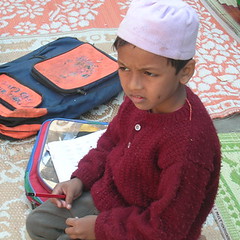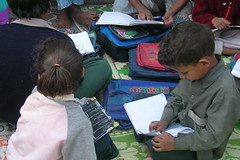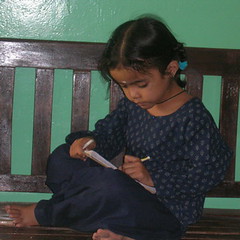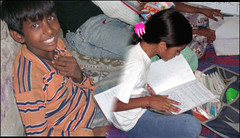
by Anuradha Bakshi | Dec 8, 2006 | common school

I have watched with despair the comings and goings of the new admission policy for nursery classes in public schools for quite some time. Had it not concerned children, I would have been amused.
We are once again faced with the normal beating around the bush attitude that we seem to have perfected to a T in India. Many of us have known the woes of getting children admitted in schools. The scurrying around to different parts of the city clutching forms and dragging a bewildered if not traumatized kid. This after having subjected your darling to distressing sessions of one of the numerous teaching shops that have mushroomed.
So when a petition was made to the High Court about setting a child friendly admission process we were all relieved. But the feeling was short lived as the point system proposed seemed far from clear and open to many interpretations. The one that caught my attention was the fact that interaction with parents was allowed but not interviews. I wonder who will decide if the lines have been crossed. I cannot see desperate parents getting drawn into a semantic or linguistic battle!
One of the parameters stood out: proximity to the school. In it I could almost sense an imperceptible step towards the common school, something I have always held as a solution to many of the problems that plague us.
Nursery admissions in the capital’s municipal school is still fairly easy. here the problem lies in convincing the parents. A quick perusal of any part of our city shows that it is dotted with government run schools – notwithstanding the state they are in – and all have ample land around them.
Children should be able walk to their school. Imagine if that were true: no buses or rushing RTVs, no long hours spent commuting…
What a dream
–Powered by Qumana

by Anuradha Bakshi | Nov 26, 2006 | common school, two indias

These little children sit on a wind swept terrace, on top of a tiny jhuggi overlooking a sea of slum dwellings in India’s capital city. A few days back they use to spend their times, roaming filthy lanes. Copy or slate in hand they wait for today’s lesson. A palpable energy pervades the little rooftop. A quick roll call proves that caste or creed is no bar here, the common denominator is learning!
Now what they will learn depends on the two teachers one a tribal the other a Muslim, an unlikely combination brought together by pwhy! They are willing to imbibe whatever they are taught.
A recent survey in a leading magazine proved that education in India, even if it is imparted in the best school, is way below international standards. What is excels in is learning by rote. Where it fails is in making connections. Hence though a child knows the composition of water, he/she is unable to give the composition of steam as he/she fails to make the link between the two. And the list is endless..
Today education is a number game with percentages rising to unbelievable heights and children cramming knowledge without often comprehending it let alone seeing its relevance in everyday life. I remember taking a class in the early days of pwhy where I asked class VII and VII children to identify one area where percentages played an important role. the lessons was about fractions. needless to say no one came with any answer and they were all surprised when I told them about sales whereby reduction were offered in percentages: 50% off, 20% saving etc.
I have always held that the Delors (UNESCO) four pillars of educations are essential to any sound education programme . They are:
Learning to know: Thinking abilities: such as problem-solving, critical thinking, decision-making, understanding consequences
Learning to be: Personal abilities: such as managing stress and feelings, self-awareness, self-confidence
Learning to live together: Social abilities: such as communication, negotiation, assertiveness, teamwork, empathy
Learning to do: Manual skills: practicing know-how required for work and tasks
Knowledge is useless unless the student has the ability to apply it to everyday situations. That is where our system fails us.
Unlike upmarket children, slum kids tend to start schooling at a much later stage. And unlike their rich counterparts, their living skills are tested at a very early stage. Tiny kids cross busy roads to shop for their mothers, or learn to fight for their rights when they are barely toddlers. I was surprised to see how a young five year old who had never learn arithmetic could account for the money given by his mother. I have seen little girls intuitively knowing what to do to soothe their howling sibling.
These children who by force majeure have to begin life using the 4 pillars we mention, quickly forget them as the enter the gates of a school. There the only thing they are judged is their ability to regurgitate the lesson.
Education is above all the ability to assimilate, analyze and then use the knowledge acquired and a self-respecting system should teach just that.
I will end this post by sharing a personal experience. When I sat for my French baccalaureate the history syllabus was the history from of the world from 1914 to present days. The final exam was summed up in one question: Had the allies lost the war, what in your opinion would have been the present economic scenario? (the year in question was 1967). Even if you had mugged up the entire book you would not have been able to answer the question if you did not have the ability to apply what you had learnt to a given reality. There was no right or wrong answer; you were judged by your ability to defend your opinion.
Therein lies the difference.
Powered by Qumana
by Anuradha Bakshi | Nov 1, 2006 | common school, girl child
My limousine had not come so I decided to spend some time in the creche where the big section – all between 4 and 5 – sat in a circle for its daily activity.
The past few weeks had been so hectic that I had barely found time to spend with the children as I was busy struggling to survive. But the breakdown of the three wheeler – ie my limo – allowed me that luxury. Once the children were settled and work handed out, I found myself staring at this little circle of around 15 kids and knew that there was something I could sense but not yet see!
It took me a few minutes to register what was disturbing be, till I felt hit by a bolt out of the blue: there were only 3 girls in the group!
It is true that the socio-economic profile of the early education group has always been different to the other sections. I guess that the presence of volunteers of all shades and hues and the fun and laughter that often emanates from this group made many slightly better families bring their children to us. This has been god sent to one like me as it was almost a precursor my dream of a common school as the solution to many problems in our country.
It is also true that the sex ratio of south Delhi is one of the worst – 784/1000 – but it is only today that I saw the chilling numbers it the very micro sample that is pwhy.
There are missing girls and we cannot afford to turn a blind eye. The importance and essential value of the girl child has to be restored in the minds of each and everyone.

by Anuradha Bakshi | Oct 18, 2006 | common school

If all goes well tiny tots in Delhi will not have to face the dreaded interview to get admission in a school. However the procedure suggested seems rather complex. Whereas the 20 points given to proximity is a great one as it maybe be the harbinger of the still elusive common school, the 20 marks reserved for the education of the parents seems to deal a blow on those who may want a better tomorrow for their kids. Even if their relentless hard work can meet the fees, they cannot reinvent themselves.
I wonder how transparent this system is going to be, and how it will actually work on the ground. It is sad that one has become so used to people circumventing the system in today’s India, that even before a new system has been set in place, one is looking for the loopholes and ways to beat it.
However for those who love kids, it is a huge relief to see that they will not be subjected to grueling preparations at an age when all they should be doing is discovering themselves and the world.
In a country where education is a constitutional right, every child should have a place in a good school. Whopping amounts are spent on universilisation of education, but the ground reality is abysmal. Even in the country’s capital city schools lack basic amenities like toilets, drinking water and sometime even a roof. If state run schools were improved then many parents would find it a good option for their children as a simple perusal of the city’s map shows that every locality has a school at walking distance.
Long and dangerous journeys in badly driven vehicles is not what any parent wants for his child, but the social mores renders the government school infra dig. Like many things in India, the solution lies in a reversal of the present way but no one is listening, or rather no one wants to.
Powered by Qumana
by Anuradha Bakshi | Aug 25, 2006 | common school, reservations, utpal
In the wake of the reservation issue and keeping in mind the abysmal state in which education for the less privileged is, many questions come to mind. Today’s paper published a report on India’s capital city which states that over 100 000 children in the age group 6 to 10 do not go to school. These are kids for which doors closed before they could open.
Then the question one could ask is who is the reservation for, when no one seems bothered about a huge section of the children of India.
Instead of thinking of basic education, the powers that be are busy placing quotas in institutes of high learning.
I am convinced that each one of these 100 000 kids is a potential entrant to the best institution, if given a chance no matter what label our divisive society choses to stick on his face. Force majeure made us find a boarding school for Utpal whose labels are quite fuzzy. His alcoholic mom hit rock bottom and had to be sent for a detox programme, and his ‘father’ just vanished.
Utpal goes to a boarding school where he shares his dorm with children coming from diverse socio-economic backgrounds. He has integrated and learns happily with his little mates, rides a horse, plays games, sings along and does what kids his age should do. All doors are opened for him and as years pass he will walk through the ones he choses and could become anything from a rocket scientist to a choreographer!
My impossible dream is to take 10 underprivileged kids age 4, belonging to various deprived groups , castes and creed and put them in school and watch what happens when they sit for their class XII. Unfortunately I do not have the funds to do so as it would cost around 4000 rs a month for each child – not a huge amount when you see what it gives and one compares it to what one spends on a child in a city like Delhi.
One needs a corporate of philanthropist to set aside the corpus that would revert back at the end of the education cycle. The common school is a pipe dream because of bizarre misconceptions, or rather because of a warped status symbol syndrome. The young principal of Utpal’s school was initially a little hesitant, but a short week after Utpal’s admission he was the one to send me a message telling what a great kid he was!
It is time someone thought of giving underprivileged children all the support they need in schools till the day we can have the elusive common school. The children of India have waited 60 years or 3 generations in the hope that something will happen. How much longer will they have to wait.
One has to understand that is is not separate schools, or parallel education programmes that will solve the issue, India will find its identity when children of all walks of life learn to live together, respect each other and learn from one another.
Children have a great way of adapting to situation and imbibing new ways.. it is our duty to give them that opportunity, till date we have failed to do so.. how many more generations will have to wait for us to see the light.

by Anuradha Bakshi | Aug 19, 2006 | common school

Three news item caught my attention today. Little Pakhi, age 6 is thrown out of her school bus as the driver brakes suddenly and dies on the spot, her school barely a 10 minute drive away from her home; 665 migrant labour come Delhi everyday and four years down the line, our government has not found the time to ensure that the the 82nd amendment is passed as mandated by the constitution of India to ensure that every Indian child has a right to free and compulsory education..
In my mind, all these issues are linked by one thread: education. If pakhi could have walked to school she may not have dies, if the 665 migrants had better options for their children – read good school – in their habitat of origin they would not have come and as for the last item it simply that the right to education bill is a bill without a will!
I would like to ask our politicians and law makers if the 3% extra allocation needed to give children their fundamental right at a time when we boast of a 8% increase is because children are not yet a vote bank to woe, or because they do not have a voice or because having large number of illiterate people will ensure manageable and influenceable vote banks: in a word, is this right not been given to children for some Machiavellian reason.
There are others rights enshrined in the constitution that are the right if everyone born in this land, but without education they become superb tools of manipulation and political battles using the cleverly nurtured illiterate base.
What our law makers do not understand is that education is the only way India can change. A citizen who can read, write, have access to knowledge, will undoubtedly rid the land of corruption ensure that projects are executed, make the rulers accountable.. and democracy functional.
But then the question that comes to mind is do we really want democracy or have we just shrouded our feudal ways in the garb of democracy.
I get appalled and my blood runs cold when i see the sustained care with which governments are wanting to privatise education. Why not democratise education and have a common school to which little Pakhi could have walked.
The 665 migrants who will bring kids with the hope of a better education will soon find that education is better in small towns as we have seen time and again. They will go looking for some shady mother nonsense convent and spend their meagre resources on trying to get their kids educated till their own illiteracy because the cause of the kids dropping out, their homes relocated to barren areas or too poor for join the tuition raj and though they belong to the OBC quota policy, the system would have made sure that they are never likely candidates.
Common schools all children would walk to could have with peer bonding may have made that possible. Mothers like mine wanted their child to be born a in a free India, but 60 years down the line are Indian children free..











